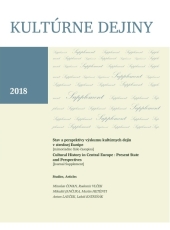Chov ruských chrtů jako nástroj poznání ruské minulosti
Breeding Russian Greyhounds as a Tool for Understanding Russian History
Author(s): Radomir VlčekSubject(s): History, Cultural history
Published by: VERBUM - vydavateľstvo Katolíckej univerzity v Ružomberku
Keywords: Cultural history; history of Russia; everydayness; hunting; dog; borzoi
Summary/Abstract: The essay comments on breeding Russian greyhounds – borzois – as an activity characteristic of the Russian cultural historical milieu. The borzoi was traditionally connected with the life of the Russian elites. The monarchs treated it much like the soil. For centuries, the Russian greyhound was not sold, only gifted. Usually for faithful service or as a national donation. It also appears in Russian literature as a symbol of the specific features of the Russian life. For example, the slavjanophile Alexei Sergeevich Chomyakov used it in his explanation of one of the differences between the Russian and West European milieus. The essay has an analytic-synthetic character with application of the methods of comparison and historical analogy.Dog breeding is a common human activity, which has accompanied the man for centuries. However, it’s practical aspect consisting of the dog’s help in provision of security to the human dwelling and the livelihood gradually dropped, being replaced with the role of entertainment. As the human life became less and less determined by the nature, the dog’s position as a symbol of symbiosis with the nature, which the cultural man boasted of especially in the modern time, was growing. Commanding the dog by the man even became a symbol of his ability to control nature. The Russian greyhounds – borzois – were bred for defense of the Russians against attacks of wolf packs or other dangerous animals and help in hunting of smaller animals, which served as their food. However, the elites of the Russian society used them increasingly for hunting, which was not necessary. Alongside other symbols, they desired to show their uniqueness also through this dog, trying to make it exceptional also by its appearance. This dog became part of the identity of the Russian noblemen as well as their supreme representative who started to use this specific feature of the Russian lifestyle also as a state donation. In this activity, he claimed the right, much like in case of other movable or immovable objects, to make his own decisions in the transactions with it. A borzoi could not be simply purchased. It could only be donated or exchanged. This situation did not change until the rule of Tsar Alexander II of Russia (1855–1881) and his great reforms. Within legalization of capital entrepreneurship and abolition of serfdom, the economically successful elites of the Russian society established unique borzoi breeding stations and held exhibitions and hunting competitions in an effort to demonstrate their uniqueness. Similar pastimes abroad made the Russian elites exchange and trade the dogs, but also set standards of what the “genuine” Russian borzoi should look like and what its features should be. Then they boasted of it as an excellence typical only of the Russian milieu. As it is clear from an example of the most important Russian breeding station owned by the Grand Duke Nicholas Nikolaevich in the second half of the 19th century in Pershin, the Russian greyhound became a symbol of their specific identity and their way of life. In October 1917, in their effort to exterminate all previous symbols of identity and manifestations of the lifestyle, the Bolsheviks devastated the breed of the Russian greyhounds. These dogs were killed not because of hunger, as it was the case of other dog breeds, but “only” to eliminate transfer of certain symbols of the tsarist or noble thinking into the everyday communist life. Fortunately not quite successfully. At that time, Russian greyhound breeding stations already existed abroad – in Great Britain, Germany, Poland and Czechoslovakia. The breeding of borzoi with its specific features became a part of the cultural history in the 20th and 21st centuries, though with different identity and exceptionality. Thanks to its looks, exceptional motion properties, but also its behaviour, the borzoi is an extremely valuable breed which, however, demands a somewhat different way of life than the more common breeds.
Journal: Kultúrne dejiny
- Issue Year: 9/2018
- Issue No: Supplem
- Page Range: 30-59
- Page Count: 30
- Language: Czech

